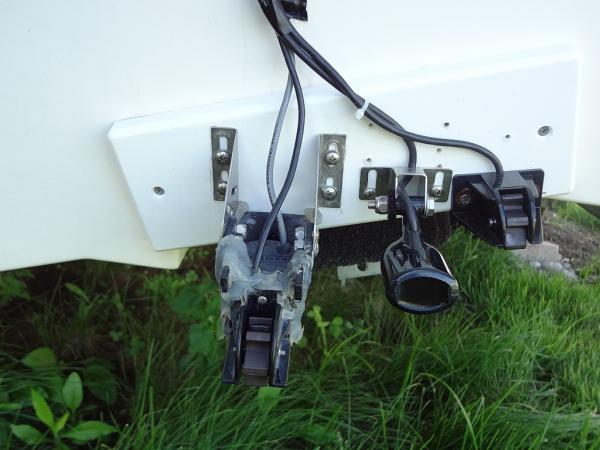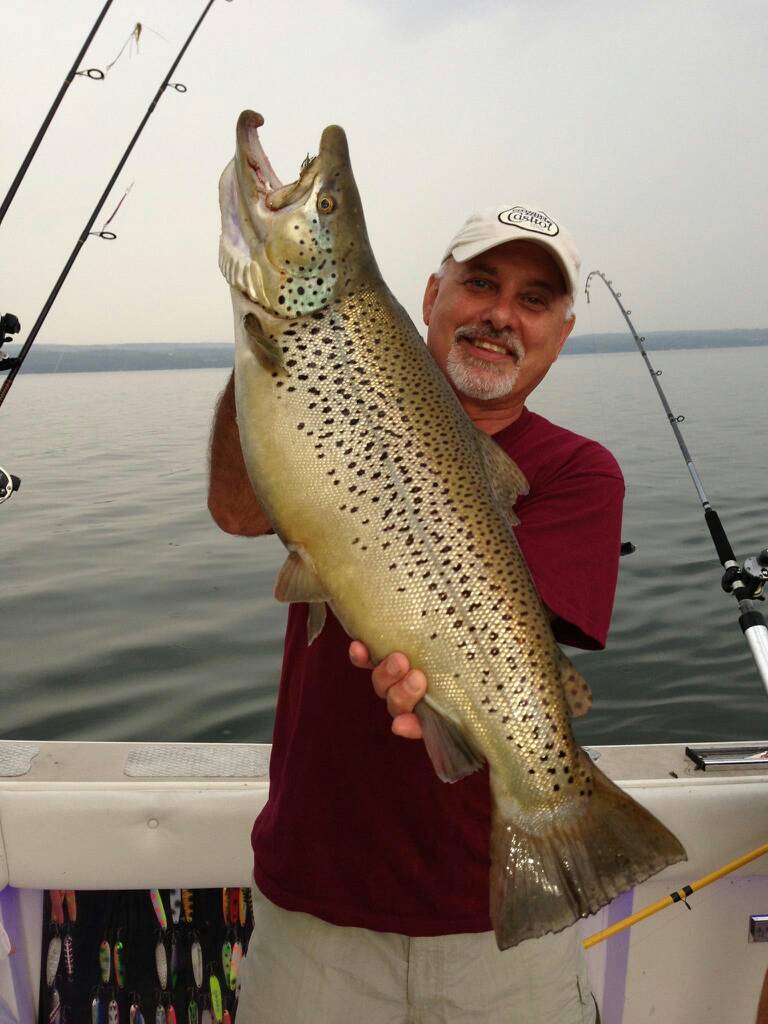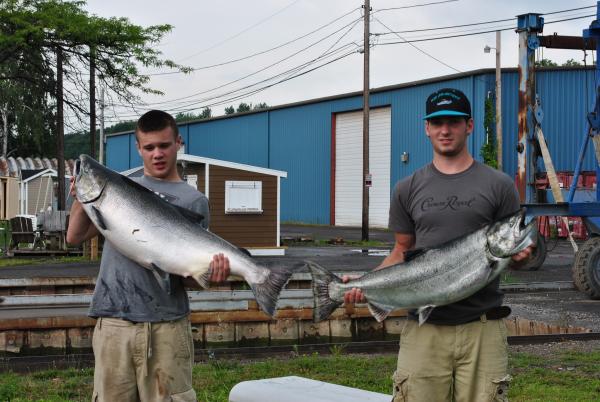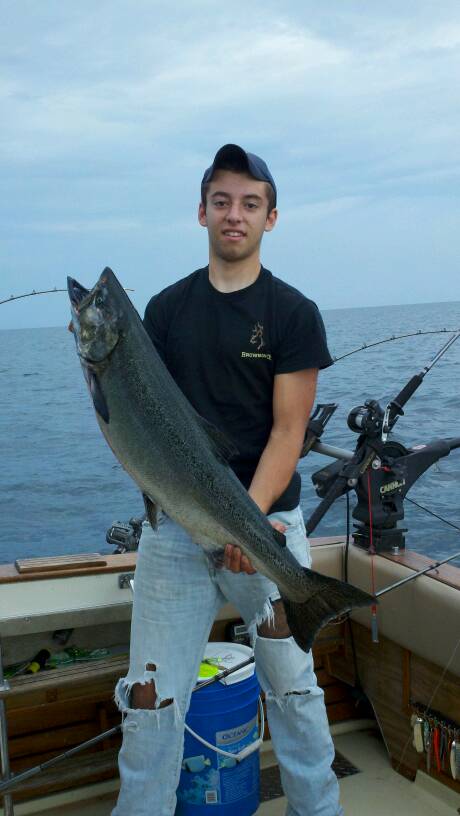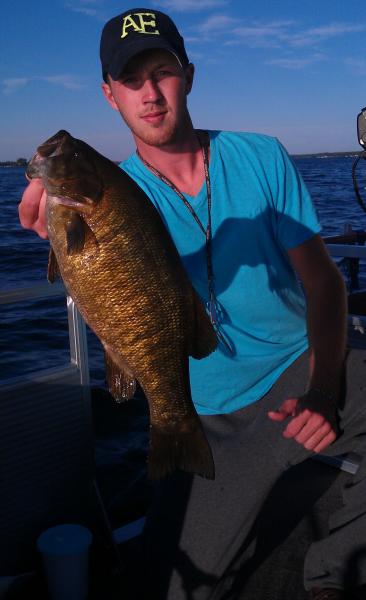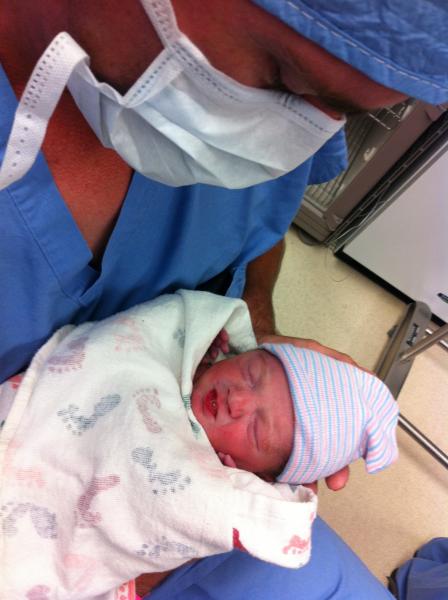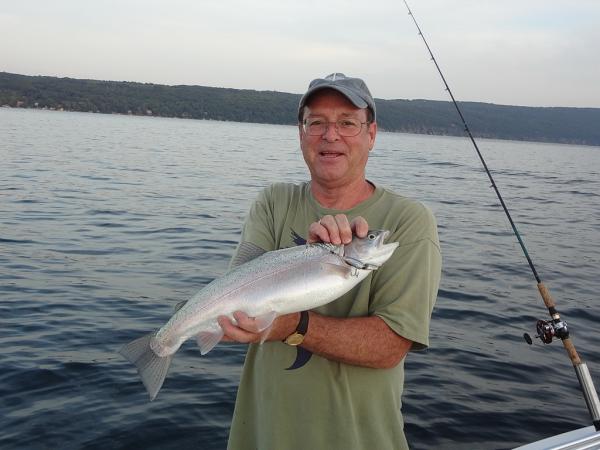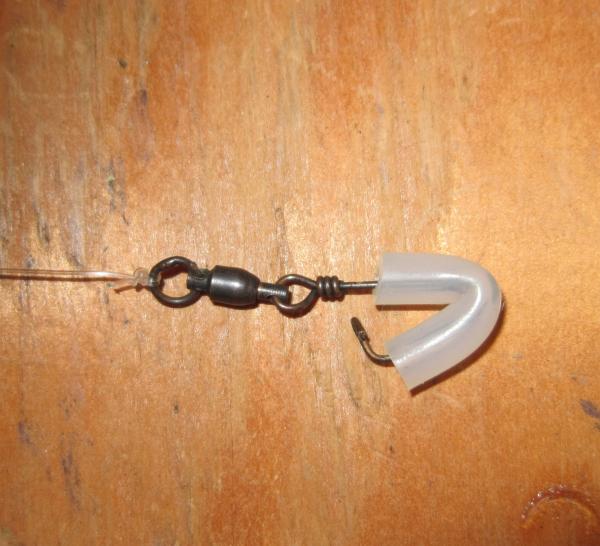-
Posts
13,807 -
Joined
-
Last visited
Content Type
Profiles
Forums
Events
Gallery
Store
Everything posted by Sk8man
-
I know this is a little off target but it applies to placement of transducers etc. and may offer ideas to others. When I bought my current boat new 12 years ago I had a piece of plastic material (Cabela's I think) installed with 2 stainless screws to the transom in a general location where I intended to place my transducer (s) on the opposite side of where my kicker is mounted (i.e. away from turbulence). The piece is long enough to allow placement experimentation as well as installation of multiple transducers as over the years you replace depth finders with different brackets etc. This allows the careful drilling of holes but doesn't affect the transom in any manner so no matter what I decide to do there will always be only two holes in the transom (screws totally sealed on installation). I have never had any problems with any of the installations using this. Here is a pic of it:
-
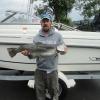
Flasher always with fly?
Sk8man replied to onion's topic in Questions About Trout & Salmon Trolling?
Usually run behind a Spin Doc, flasher, dodger, or small jet diver but in the old days larger streamer flies were trolled by themselves back aways off fly rods (sometimes with a few small splitshot ahead of it) primarily for rainbows. -
As Shinintimes put it the answers to your questions aren't "short and sweet" or simple for that matter. Aside from the very good things that have already been mentioned it should be understood that the so-called "ideal " temperatures given for a species are not to be taken as fundamental absolutes. Most fish will go out of their preferred temperature ranges for a variety of reasons. They are at best indicators of possible places in the water column where fish may be found. Baitfish also have preferred ranges of temperature and many times in the summer the range intersects the bottom which is why you often see them hanging there and many times with fish nearby and sometimes out of their supposed temperature range...you notice I keep saying "range" and it is because most fish can tolerate a number of temperature values but they also may not readily be found in some others and they may be found at different temps at different times of the year. For example browns are quite temperature sensitive especially in the Spring and Fall and they may locate within the warmest temp range they can find at that time of the year (eg. near power plants or other sources of warmer water where the water may be a couple degrees higher than the surrounding water)). They are also known to be able to adapt to much warmer water (even 75 degree water temporarily) than either rainbows and steelhead or especially lakers. During the summer months they are usually found hanging near bait and near drop-offs and just above bottom near active stream mouths and the temp at the bottom there may be quite a bit colder than the reported temp preference for them. Water temperature is an important variable in the trout and salmon life cycle but it is far from the only thing that places them at a given depth or place in the water column. Marking bait and fish in close proximity to it may be as important ( or perhaps even more so sometimes). Knowing the particular general habits of the target species may be more helpful than electronics. Consider trying out a heavier weight (e.g. 12 lb.) for your downriggers and perhaps check the adjustment of the angle of your transducer (if it is a transom located type (not a thru-hull), and perhaps play with it a bit to see if you can spot your downrigger balls in the water column. It is an important factor in the use of your fish finder to know where your lures are running. The suggested printed angle values for transducers are usually considered as the "optimal" placement as related to marking depth at speed but they often will tolerate some movement or adjustment and still track range and downriggers OK. If you can accurately mark your weights the "blowback" issues can be minimized regardless of the line counter readings of the reel or downrigger. Use the depth finder to make the adjustments when you can. There may be times (for example on turns and at higher than normal speeds when the weights will be outside the cone anyway.
-

portable fish finder for pier fishing
Sk8man replied to oneluvunknown's topic in Tackle and Techniques
Pier fishing is a whole different bag than boat fishing or stream fishing for that matter. You are limited tremendously by the stationary nature of it which means that the probabilities of being in the "kill zone" are much more limited. Even if you had a fish finder that would spot potential target fish because of the shallow nature of the environment you have no idea whether they are bass carp or salmon for starters. When you are out in a few hundred feet of water and the large marks are suspended and streaking toward your trolled lures you have a better idea that they might be salmon but it is still not fool proof. Near shore and onshore fishing is usually a hit and miss proposition at best. When the fish are in and you happen to be there (or better yet you calculate to be there based on actual previous observations) you may luck out but more often than not if you aren't there nearly every day during the"critical period" you will miss a large part of the action...it is the nature of the beast. At that time of the year salmon respond differently than in the summer when they are actively feeding heavily too and many of the hits are out of aggression rather than from a feeding response so you brighten up the colors etc. to "provoke" them into striking rather than "enticing" them for a feeding response. What I am getting at is that it is the approach to the fishing situation that will put you on fish not the electronic "gizmos". By closely monitoring the site every chance that you get and trying different lures, presentations, closely studying the structure and specific depth profile around the pier and putting your time in at the pier will offer more rewards than depending on the electronics hype. The actual teaching of the fishing tactics and spending the time may prove more valuable to your relationship with your step son too than the fishing results. We often seem to believe that instant results are the only thing that matters (the American way :<) but the more important things tend to be the spending of time doing something together (i.e. quality time)....based on experience with my own three kids. -
Yeah I guess I really "get into it" sometimes in the way of details ...but I hope it helps you out... Canandaigua is often a challenge but especially so this year with the die off etc. All these lakes have their "ups and downs" or cycles and usually just when you think you have it dialed in everything changes but that it what offers the challenge and makes it fun. Best of luck to you fishing. Les
-
-
The usual or standard rigging methods involve 7 or 19 stranded stainless wire and the hardness of it and abrasiveness of the strands over time acts somewhat like a saw on the tip and guides of conventional rods that don't have specially hardened tips and/or guides. The 19 strand wire is reputed to get away from this but I haven't had first hand experience with it. Supposedly the wire is more rounded so there is less of an "edge" to it. The wire can also cut some soft metal in level wind mechanisms. I have for example some Penn reels from the past that have such grooves or cuts in the level winds because they were softer than the ss wire I had used... To get away from this roller tips or twilli tips are used to reduce friction on the tips and line guides as well as allow the wire to keep from kinking or bending abnormally (to a degree). One way to get around this is to use wire that is "softer" than the tip metal or line guides - monel and copper are such wire and there are others such as perhaps the piano wire (smooth not stranded). Another angle that is pursued is to make the tips and line guides from very hard metals or composites that have a hardness greater than that of the wire....titanium is one such metal but it is expensive to use in the manufacturing process so it is usually only seen in high end equipment. Specially manufactured (hardened) carbide composites or special ceramic materials and coatings are used in less expensive options - usually as inserts to the tips and guides.
-
Thanks Andy. Keep at those fish!
-
Wire has a lot of "spool memory" and it helps to put on some mono (not braid) backing (even if just a hundred ft or so on the spool before putting on the wire so that it nests itself more evenly. My hunch is that a possible factor in your situation may have been the location of your level wind when you started to put the wire on. If it was off to the side rather than straight on it may have caused the wire to be on a diagonal as it was wound on the spool and that often leads to the messes you described. Just an attempt at "arm chair analysis" but possible. As Dave mentioned tension is constantly required when using wire (which also leads to spool memory but there is no escaping it). I usually loosen the drags on my reels when not in use but with the wire rigs I don't for that reason.
-
1000 ft. of 30 lb test 7 strand Accustrand, Malin or Mason is good for starters for each reel if you are talking fresh water for salmon and trout. There is also new 19 strand wire that you may wish to consider as well. For rods - either roller tips or twilli tips are wise choices and length is basically a personal preference issue but it should have some backbone to it . For reels it will largely depend on what you can afford but you need to make sure they have a good drag system or upgrade them with the carbon fiber drags and they need to have enough capacity to hold the 1,000 ft of wire. Line counters are very desirable too and the level wind guide mechanism should be made of a "hardened" material or have a hardened insert to avoid excessive wear on it or the wire line over time. A loud clicker is also helpful in being able to hear them above engine noise etc. You might even want to start with just one rig and see if that particular setup works the way you desire before buying a second one and go from there. You will find a lot of die hard Okuma, Shimano and Daiwa folks (myself among them) here but I would suggest that you go to a tackle shop (some of them advertise on here) that stocks a few different models and brands and try to get a "feel" for them and listen to the clickers, check the weight of them against your preference and intended rod etc. A lot of folks sell rods and reels here and on Ebay, Craigs List etc. that just ordered on line or went out and bought stuff they ended up disliking for a variety of reasons. Some places have combos already set up with wire so that you can try them for drag smoothness, clicker noise and general operation. Sometimes there may be trade-offs for example such as the Saltist issue of direct drive line counter which is accurate and functional but some folks object to it's placement at the side of the reel as being uncomfortable....you wouldn't know that from ordering it online or getting an opinion from someone who is in love with the reel and doesn't see it as a significant problem.
-
-
Sean, Thanks for the report and great fish! Things are really shaping up out there.... Les
-
Good going Andy! What is the grass and flea situation like out there now? (Just returned from the Cape so haven't heard anything since I left). Both the bows and landlocks are a lot of run and can be hard to hold on to
-
Hey Nick and Theresa. Congrats on the nice King.....quite the specimen... I just now got back from Cape Cod. Unfortunately I didn't take my boat and surf casting for the stripers was out because the high tides were about 2 PM and that's when all the beach goers were there so I couldn't even fish for them. I usually go in August when the high tide is early AM so I guess that's it for this year...I did score some nice jigs while scouring the tackle shops to try for Finger Lakes trout that you can't find around here though so it wasn't a total loss Les
-
-
-
I think the Blood Run See Flea is the way to go. I'm going to spool up a couple more reels with it after testing it out last night on Canandaigua....worked like a charm with 17 lb 8 ft. leader of Fluoro...no fleas on it whatsoever while I had some on the 30 lb wire rig....limited test but it persuaded me to use my other two rolls of it. After years of fishing with 10 and 12 lb test it takes some getting used to using 30 lb anything...feels like I'm using anchor line I also forgot to mention....the See Flea line seems to float quite a bit on the surface as you let it out (probably the sliicone coating) so may be better for downriggers etc. than as a top line
-
Thanks guys. Hey Justin I hear ya on the Nauset area....last couple years they have closed the beach because of the Great Whites grabbing the seals there My in-laws live in Eastham so I'm pretty much an outer Cape dude Been going to the Cape since 1967. We used to fish the rip tide out from Chatham right off Monomoy with sand eels and nailed a lot of real hogs there but as you mentioned the seals and sharks are now a real problem out there. I've fished out of Rock Harbor, P town, Dennis, and Wellfleet but have never fished the Cape Cod Canal. This year I may be limited to surf casting off Coastguard Beach or Nauset and hopefully won't hook on to a Great White
-
My buddy Mike and i went out at about 6:30 tonight until about 9:45 PM in his boat.We put out 2 downriggers a wire dipsey with flasher and fly combo and a small dipsey without the ring near German Brothers in about70 ftw. A little while into it I had a good hit on the F/F (mountain dew with green and white fly). A first I thought it felt like a medium sized fish and I started to take up some slack with him coming toward the boat and then he started really thrashing and took out a good deal of wire three separate times. The rod was bent pretty good too (stiff roller tip rod). I got him half way in and I felt him let go....never got a look but whatever it was it was a real good fish....kept trolling south on west side and trolled to the condos and we picked up two rainbows one on black Evil Eye and one on a small hand painted rapala that Mike custom painted himself with auto paint and he said its his all around best lure. His fish was badly injured so it was kept. Mine was released unharmed to fight another day and it fought valiantly for me ...one of its several jumps was about 6 ft in the air. We encountered a little grass but not bad. The fleas were there but not bad either. The new Blood Run flea line never had any fleas whatsoever while the wire rig picked up a few at the terminus. It was an incredibly beautiful night and we savored it and especially the breeze all the way back to the launch ramp after the heat today. Next fishing stop Striperland ( Cape Cod Saturday) Oh yeah...Mike and his rainbow
-


